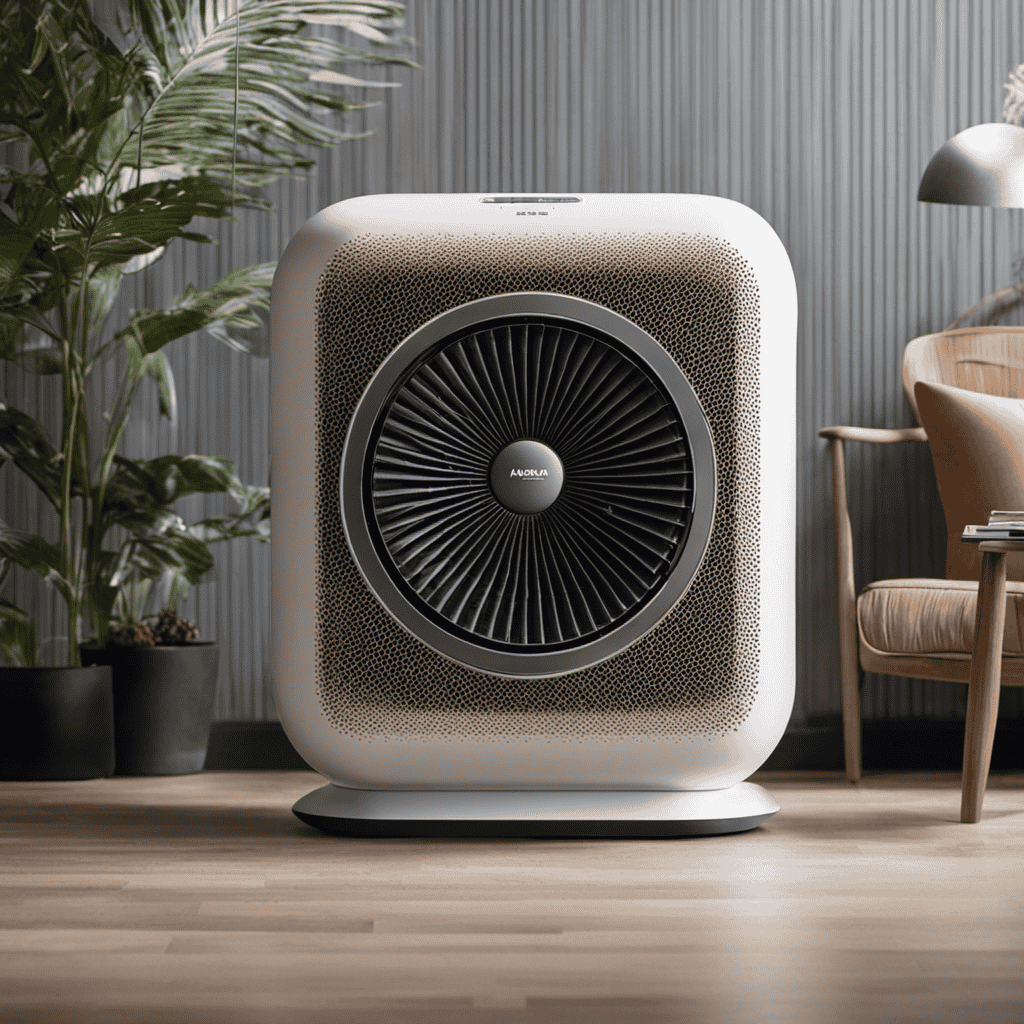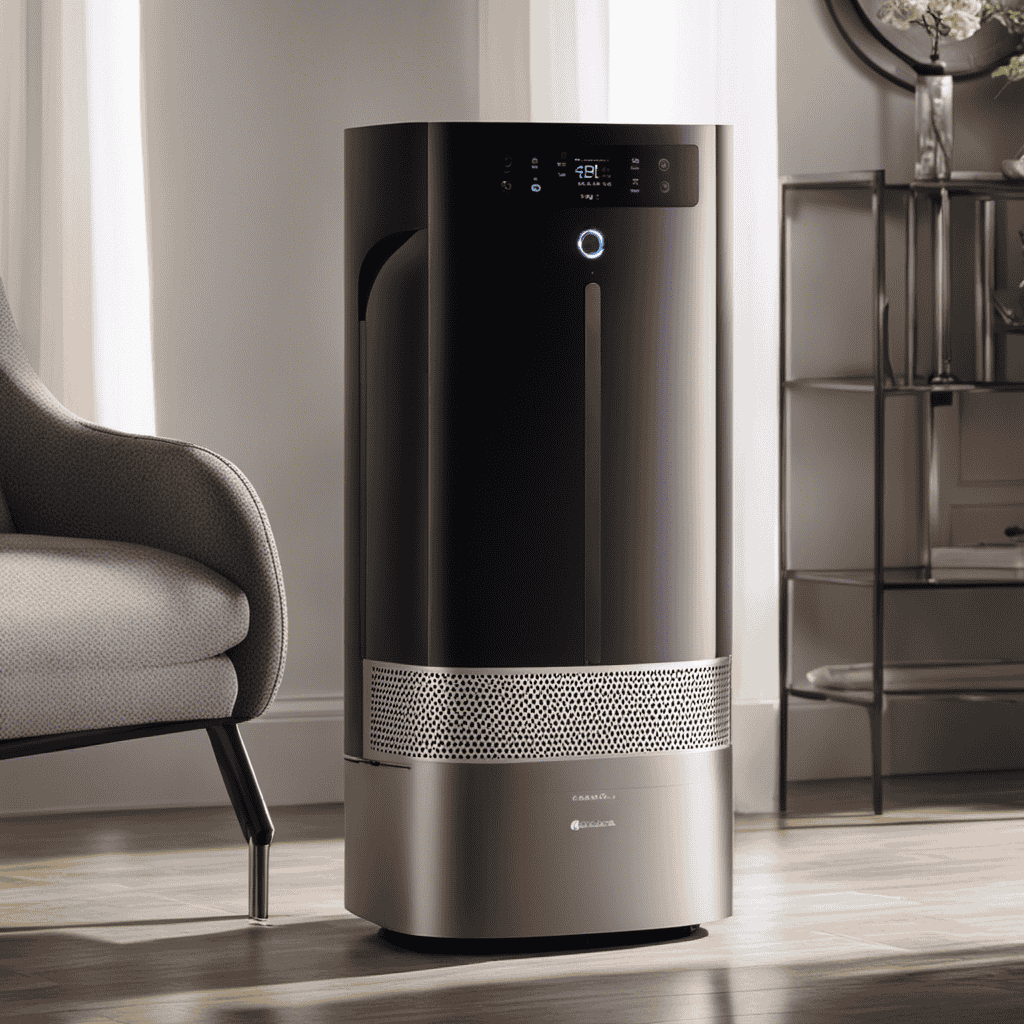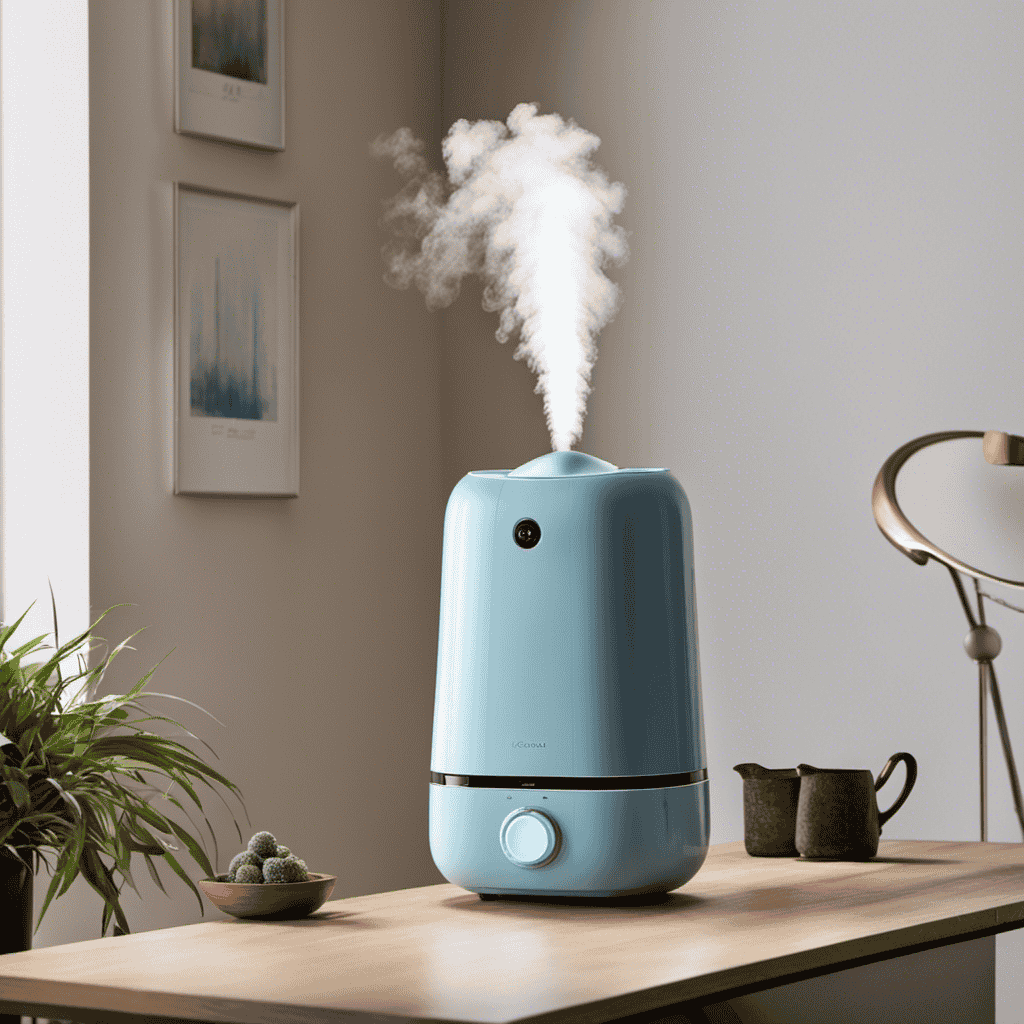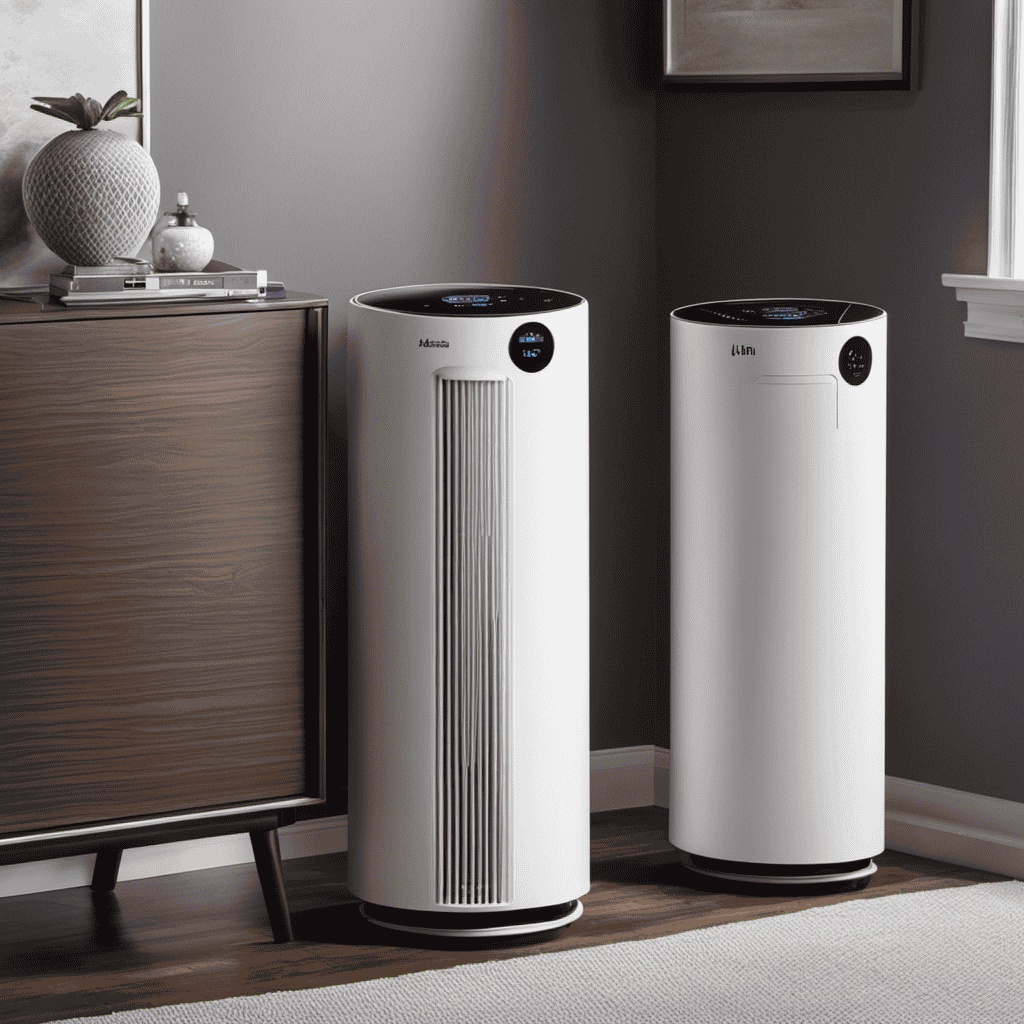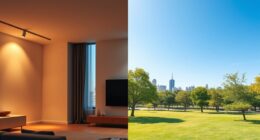When it comes to ensuring clean air in my home, I aim to have the top-quality room air purifier. With numerous options available, it can be daunting to select the perfect one.
That’s why I’ve put together this guide on how to choose a room air purifier. I’ll walk you through understanding your air quality needs, considering room size and coverage area, evaluating different technologies, and more.
Let’s clear the air and find the perfect purifier for you.
Key Takeaways
- Understanding air quality needs and identifying specific pollutants helps select the right air purifier.
- Considerations for room size and coverage area are important when choosing an air purifier.
- Evaluate different types of air purification technologies to find the most suitable one.
- Consider noise level, energy efficiency, and maintenance requirements when selecting an air purifier.
Understanding Your Air Quality Needs
Understanding your air quality needs is essential when choosing a room air purifier. Air quality monitoring plays a crucial role in determining the type of purifier that will best suit your needs.
By monitoring the air quality in your home, you can identify specific pollutants or allergens that may be affecting your health. This knowledge allows you to select an air purifier with the appropriate filtration system to target those specific contaminants.
Moreover, investing in a high-quality air purifier can provide numerous health benefits. It helps remove harmful particles such as dust, pollen, pet dander, and mold spores from the air, reducing the risk of respiratory issues and allergies.
Breathing cleaner air can also improve overall well-being, leading to better sleep and increased productivity.
Consider the Room Size and Coverage Area
When it comes to choosing a room air purifier, it’s important to consider the size of the room and the coverage area of the purifier.
The room size is crucial because it determines the effectiveness of the purifier in cleaning the air.
Additionally, the coverage area is important because it indicates how much square footage the purifier can effectively clean.
Therefore, it’s essential to choose a purifier based on the dimensions of the room and the desired coverage area.
Room Size Importance
The size of the room is crucial when selecting an air purifier. It determines the effectiveness of the purifier in providing clean and fresh air. To choose the right air purifier based on room size, consider the square footage of the room and the air quality requirements.
| Room Size | Air Quality Requirements | Recommended Air Purifier |
|---|---|---|
| Small | Low to Moderate | Compact air purifier |
| Medium | Moderate to High | Medium-sized air purifier |
| Large | High | Large air purifier |
For smaller rooms, a compact air purifier is sufficient to maintain a healthy environment. In medium-sized rooms, a medium-sized air purifier is recommended to effectively remove allergens and pollutants. For larger rooms, a larger air purifier with higher filtration capacity is necessary to ensure optimal air quality. By selecting the right air purifier based on your room size and air quality requirements, you can create a healthier and cleaner living space.
Coverage Area Considerations
To effectively determine the coverage area of an air purifier, consider the square footage of the room and the desired level of air purification.
The size of the room is crucial as it directly affects the effectiveness of the purifier. A larger room will require a more powerful purifier to ensure optimal air quality. Additionally, the layout of the room and the placement of furniture can impact the air circulation.
It is important to choose a purifier that can effectively circulate the air in the room, reaching all corners and removing pollutants.
The desired level of air purification also plays a role in determining the coverage area. If you have severe allergies or respiratory conditions, you may require a purifier with a larger coverage area to ensure thorough purification.
Choosing Based on Dimensions
Consider the dimensions and layout of your space to ensure the purifier fits properly and circulates air effectively.
When choosing a room air purifier, it is important to take into account the size of the room. The purifier should be able to effectively clean the air in the entire space.
If the room is too large for the purifier’s coverage area, it may not be able to effectively remove pollutants and improve air quality. On the other hand, if the purifier is too large for the room, it may consume unnecessary energy and create a drafty environment.
It is recommended to check the manufacturer’s specifications for the purifier’s coverage area and compare it to the dimensions of your room to ensure a proper fit and optimal air purification.
Evaluating Different Types of Air Purification Technologies
When evaluating different types of air purification technologies, it’s important to understand their specific benefits and limitations. One of the key factors to consider is evaluating performance and comparing effectiveness.
Different technologies, such as HEPA filters, activated carbon filters, and ionizers, have their own strengths and weaknesses. HEPA filters are highly effective at capturing small particles but may not be as effective against odors and gases. Activated carbon filters excel at removing odors and gases, but may not be as effective at capturing smaller particles. Ionizers can effectively remove particles from the air but may produce ozone as a byproduct.
By understanding the strengths and limitations of each technology, you can choose the most suitable air purification technology for your specific needs.
Now, let’s move on to the next important factors to consider: noise level and energy efficiency.
Noise Level and Energy Efficiency
Understanding the noise level and energy efficiency of different air purification technologies can help you make a more informed decision. When considering which air purifier to choose, it’s important to take into account the noise level analysis and energy efficiency standards. Here are four key factors to consider:
-
Noise level: Some air purifiers can be quite noisy, especially on higher settings. Look for models with noise reduction features or low decibel ratings for a quieter operation.
-
Energy efficiency: Check the energy efficiency rating of the air purifier to ensure it won’t consume excessive electricity. Look for models with Energy Star certification for optimal energy savings.
-
Adjustable settings: Consider air purifiers with adjustable fan speeds or automatic modes to customize the noise level and energy usage based on your needs.
-
Sleep mode: Look for air purifiers with a sleep mode feature that operates at a lower noise level and consumes less energy during nighttime use.
Understanding the noise level and energy efficiency of air purifiers can help you find the right balance between effectiveness and convenience.
Now, let’s move on to comparing filter types and maintenance requirements.
Comparing Filter Types and Maintenance Requirements
Let’s take a look at the different filter types and maintenance requirements for air purifiers.
When it comes to comparing effectiveness, there are three main types of filters commonly used in air purifiers: HEPA filters, activated carbon filters, and ionizers.
HEPA filters are highly effective in capturing airborne particles as small as 0.3 microns.
Activated carbon filters are great for removing odors and chemicals from the air.
Ionizers work by releasing negatively charged ions that attach to airborne particles, making them heavy and causing them to fall to the ground.
As for maintenance requirements, most air purifiers require regular filter replacement.
HEPA filters typically need to be replaced every 6-12 months, while activated carbon filters and ionizers may need replacement every 3-6 months.
It is important to consider the filter replacement costs when choosing an air purifier to ensure that it fits within your budget.
Budgeting and Cost Considerations
When it comes to choosing a room air purifier, there are a few key points to consider.
First, think about price vs. performance. You want to ensure that you’re getting the best value for your money.
Next, consider the long-term maintenance costs, such as filter replacements. This can help you determine the overall cost of owning and operating the air purifier.
Lastly, take a look at the energy efficiency ratings. This will give you an idea of how much energy the purifier will consume, which can impact your electricity bills in the long run.
Price Vs. Performance
You should consider the trade-off between price and performance when choosing a room air purifier. It’s important to find a balance between the cost and the effectiveness of the purifier. Here are some factors to consider:
-
Price range: Determine your budget for an air purifier. Prices can vary greatly depending on the brand, features, and size of the unit. Consider how much you are willing to spend before making a decision.
-
Performance comparison: Look for air purifiers that have high CADR (Clean Air Delivery Rate) ratings. This indicates how efficiently the purifier can remove pollutants from the air. Compare the CADR ratings of different models to find the most effective one for your needs.
-
Filter replacement cost: Consider the ongoing cost of replacing filters. Some air purifiers have expensive filters that need to be replaced frequently, while others have more affordable options. Factor in the cost of filter replacements when evaluating the overall price of the purifier.
-
Energy efficiency: Check the energy consumption of the air purifier. Look for models with an Energy Star certification, as they are designed to be more energy-efficient and can save you money on your electricity bills.
Long-Term Maintenance Costs
Considering the ongoing expenses, it’s important to factor in the long-term maintenance costs of an air purifier. One significant aspect of maintenance is filter replacement. Depending on the model and usage, filters may need to be replaced every few months to a year. It’s crucial to estimate the lifespan of the filters to budget for future expenses. To give you an idea, here’s a table showcasing the estimated lifespan of common air purifier filters:
| Filter Type | Lifespan Estimation |
|---|---|
| Pre-filter | 3-6 months |
| HEPA filter | 6-12 months |
| Carbon filter | 6-12 months |
| UV-C bulb | 9-12 months |
Energy Efficiency Ratings
When it comes to maintaining an air purifier, there are a few key things to keep in mind.
Regular maintenance is important to ensure the device is working effectively and efficiently.
Here are some tips for air purifier maintenance:
-
Cleaning the filters: Most air purifiers have filters that need to be cleaned or replaced regularly. Follow the manufacturer’s instructions to ensure proper maintenance.
-
Checking the air quality sensors: Some air purifiers are equipped with air quality sensors that detect the level of pollutants in the air. It’s important to check these sensors and clean them if necessary to maintain accurate readings.
-
Dusting and vacuuming the unit: Dust and debris can accumulate on the surface of the air purifier, hindering its performance. Regularly dust and vacuum the unit to keep it clean.
-
Regularly inspecting and cleaning the fan: The fan in the air purifier helps to circulate the air. Make sure to inspect and clean the fan regularly to prevent any blockages.
Frequently Asked Questions
Can an Air Purifier Eliminate All Types of Pollutants From the Air?
An air purifier can effectively eliminate many types of pollutants from the air, such as dust, pollen, pet dander, and smoke. However, it may not be able to remove all pollutants, like certain gases or chemicals.
Are There Any Specific Air Purifiers Recommended for People With Allergies or Asthma?
As an expert, I recommend the best air purifiers for pet owners and those with allergies or asthma. The benefits of HEPA filters are immense for allergy sufferers, providing clean air and reducing symptoms.
How Often Should I Change the Filters in My Air Purifier?
I change the filters in my air purifier every 3-6 months. Regular filter changes ensure optimal performance and help remove pollutants from the air, providing the benefits of cleaner, healthier indoor air.
Can an Air Purifier Remove Odors From the Air?
Yes, an air purifier can remove odors from the air. It uses filters to trap and eliminate odor-causing particles, improving indoor air quality. This is one of the many benefits of using an air purifier.
Are There Any Air Purifiers That Can Be Controlled Remotely Through a Smartphone App?
Yes, there are air purifiers that can be controlled remotely through a smartphone app. This feature allows for convenient and easy control of the purifier from anywhere, providing benefits of remote control functionality.
Conclusion
In conclusion, choosing the right room air purifier requires careful consideration of several factors.
By understanding your air quality needs, evaluating the room size and coverage area, and comparing different types of air purification technologies, you can make an informed decision.
Don’t forget to take into account noise level and energy efficiency, as well as filter types and maintenance requirements.
Lastly, budgeting and cost considerations are important.
Remember, finding the perfect air purifier is like finding a breath of fresh air for your home.



